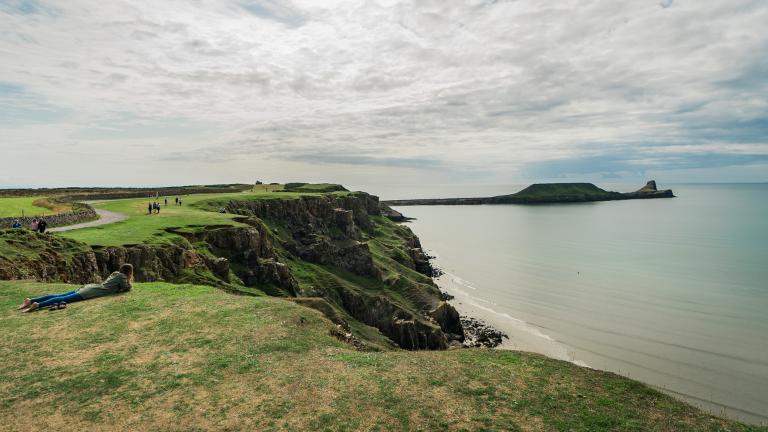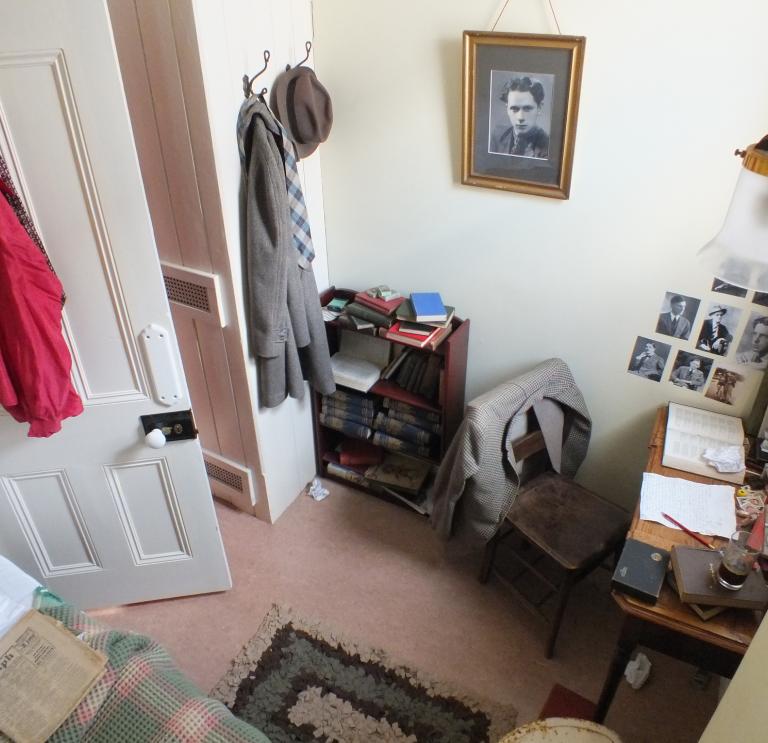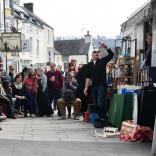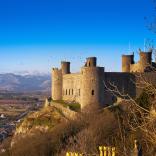Come with us, good boys and good girls, to Dylan Thomas’ Swansea, 'by the side of a long and splendid-curving shore....this sea-town was my world'. This quote from his 1943 radio broadcast, Reminiscences of Childhood, sums up the hold that his hometown had in his heart.
Dylan Thomas's writing about Swansea for the radio ultimately inspired his boisterous, brilliant ‘play for voices’, Under Milk Wood. And what a coincidence it is too, that Dylan's name translates from the Welsh as 'son of the sea', after Dylan ail Don, a character from our great ancient Welsh folk stories, The Mabinogion. So come and dip your toes with us into the waves of Thomas’ past, as his memory keeps returning to our lands, and lingers in the present.
5 Cwmdonkin Drive
Dylan not only grew up in this lovely Georgian house in the uplands of Swansea, but he was also born here, in the front bedroom. His father David John and mother Florence (known as Florrie) had bought the house earlier in 1914, when it was brand new; their firstborn arrived in the October.
Half of the poems Dylan ever had published were written here between 1930 and 1934, and it remained the Thomases’ family home until 1937. Later in the century, the house fell into disrepair, despite its old occupant's international fame. By 2003, it was a crumbling ex-student bedsit - and then another Uplands local, Geoff Haden, stepped in.
It is now beautifully restored, and furnished as it would have been during Dylan’s childhood.You can not only tour it today, but also have lunch, afternoon tea or dinner here, experience literary events here – and even stay here. See the Dylan Thomas Birthplace website for more details – and show everyone what you wrote afterwards.
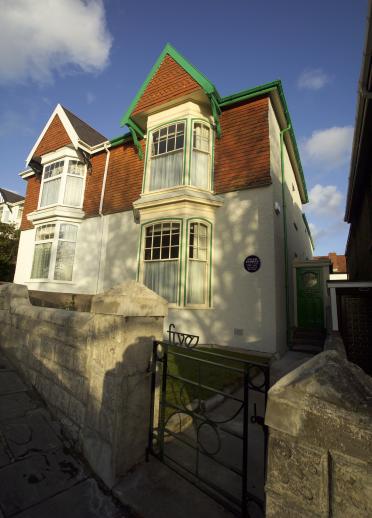
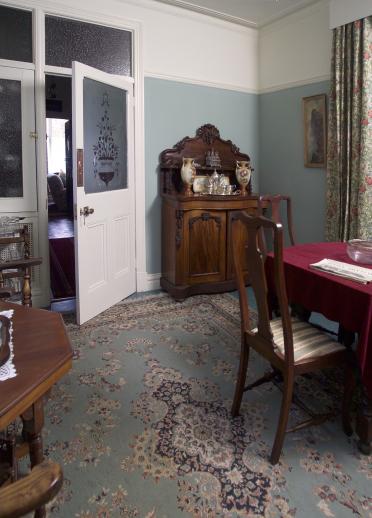
Cwmdonkin Park
The young Dylan spent his childhood playing in this beautiful, rolling park, in his own unique way. Rather than walking round to the main gate, he’d scramble over a wall to get in by the fastest possible route. Cwmdonkin Park is referred to in his Reminiscences of Childhood and another radio broadcast, Return Journey, plus a beautiful early poem, The Hunchback In The Park. This details 'the birds the grass the trees the lake/And the wild boys innocent as strawberries'.
Restored to its former glory in a £1.39 million project in recent years, the park’s famous 1963 memorial stone to Dylan has also been beautifully restored. It includes lines from Dylan’s poem, Fern Hill, ending by looking out to the distant waters you can see from the Uplands: 'I sang in my chains like the sea'.
St Helen’s Ground
Dylan’s old school, Swansea Grammar, was largely destroyed during the Second World War, the portside city was blitzed over three nights in February 1941. One special place from Dylan’s school years is still there, however: the ground where he won his school sports day race when he was 14. Its lifelong importance to him was made clear after he died in New York in 1953 – a police officer found an old newspaper cutting about the victory tucked into his wallet.
The Uplands Tavern
This is where Dylan tasted his first pint of beer, falling in love with 'its live white lather, its brass-bright depths, the sudden world through the wet brown walls of the glass, the tilted rush to the lips and the slow swallowing down to the lapping belly, the salt on the tongue, the foam at the corners'. It was The Uplands Hotel in Dylan’s day, but it has been The Uplands Tavern now for years, and is still a popular pub, with several quizzes a week, and live music all weekend.
Dylan Thomas Square
After leaving school at 16, Dylan had a short-lived career as a journalist for the South Wales Evening Post, whose offices were near this waterside square. It is also close to the busy pubs of Wind Street, where Dylan would, all too happily, disappear between shifts.
You can still see him here today too, on a square which has now been given his name. A statue of the writer by sculptor John Doubleday, perched on a chair, gazes out over the marina. Behind it is the Dylan Thomas Theatre, home to his old company, the Swansea Little Theatre, emblazoned with beautiful murals of scenes of his life. There’s also a statue of Captain Cat from Under Milk Wood nearby in Abernethy Square, proudly waving his bell.
Dylan Thomas Centre
Nearby, you’ll find Swansea’s former Guildhall, now the gorgeous Dylan Thomas Centre, which opened a brand new exhibition, Love The Words, to celebrate his life on the 100th anniversary of his birth. It boasts interactive timeline which takes you through the people who helped shaped Dylan’s life, audio recordings of the man himself, and a Children’s Trail full of the animals that feature in his writing.
Dylan the writer and Dylan the performer are both celebrated here, and touchscreens tell the story of his notebooks, and explore his most famous poem, Do Not Go Gentle Into That Good Night. Open Tuesday to Sunday, entry is free, allowing everyone access to a poet who really gloried in people.
Patti Pavilion, Mumbles Road, Mumbles
Travel along the bay down to the Mumbles, where the Swansea Little Theatre used to be based in a church hall on Mumbles Road. Dylan was also a regular in the area’s many pubs. Some of his favourite haunts, including The Mermaid, The Antelope and The Village Inn have all long disappeared. However the Patti Pavilion, built by the wealthy opera singer Adelina Patti as a winter garden, is home to Adelinas Bar and Kitchen if you're looking for refreshment.
The Patti Pavilion appears in Portrait of the Artist as a Young Dog – renamed the Melba Pavilion – and Dylan brings his well-known cheek to the reference. His character dreams of owning a huge house with 'a lavatory as big as, as big as the Melba pavilion, with plush seats and golden chains'. Patti would have been proud.
Paraclete Congregational Church
Dylan wasn’t religious himself, but his uncle, David Rees, was a preacher, living here with Dylan’s aunt Dosie. The whole family attended his Sunday services too, and Sunday services still run at Paraclete Congregational Church today. The Reverend’s fire-and-brimstone delivery had a big influence on Dylan’s own style – not that he would have admitted as much to his uncle. Dylan once wrote this memorable line about him in a letter to another brilliant Swansea poet, Vernon Watkins, 'I hate you from your dandruff to your corns!'
Rhossili Bay
Our stunning beach on the western tip of Gower was a favourite for the young Dylan. He visited on camping trips with friends, even walking the seventeen miles sometimes from the Uplands, as two of his characters do in the story, Who Do You Wish Was With Us?.
Rhossili is famous for stretching out into a rocky outcrop called Worm’s Head, a spot which you can only get to during low tide, Dylan described its majesty perfectly for those of us you know it in that same story, 'at the end of the humped and serpentine body, more gulls than I had ever seen before cried over their new dead and the droppings of ages'.
Later in life, Dylan returned here with his wife Caitlin and their friends, and they even considered moving here. Dylan dropped the idea when he realised the village didn’t have a pub. His body may lie in a coastal village further west in South Wales, but Dylan's heart would still beat here in Swansea’s fishing-boat bobbing sea, and keep on cresting for us, as it always will.
